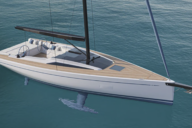Ireland-based B9 Shipping has started work on a full-scale demonstration vessel as part of its goal to design the world’s first 100 percent fossil fuel-free cargo sailing ships. Unlike most conventional large cargo vessels, which are powered by bunker fuel, B9 Shipping’s cargo ship would employ a Dyna-rig sail propulsion system combined with an off-the-shelf Rolls-Royce engine powered by liquid biomethane derived from municipal waste.
of its goal to design the world’s first 100 percent fossil fuel-free cargo sailing ships. Unlike most conventional large cargo vessels, which are powered by bunker fuel, B9 Shipping’s cargo ship would employ a Dyna-rig sail propulsion system combined with an off-the-shelf Rolls-Royce engine powered by liquid biomethane derived from municipal waste.
The company says all of the technologies that will be used in its cargo vessels are already proven and readily available. The Dyna-rig sail system was originally conceived in the 1960s by German hydraulics engineer Wilhelm Prolls and was first used by Italian shipbuilders Perini Navi in its 289 ft clipper, The Maltese Falcon, which made its maiden voyage in 2006. The free standing and free rotating system has no rigging and comprises multiple relatively small sails that are operated electronically from the bridge. This allows them to be trimmed quickly to maximize wind power and turned out of the wind in the event of sudden squalls.
The Dyna-rig sail system is expected to provide around 60 percent of the vessel’s thrust, with the remainder coming from a biogas-powered Rolls Royce engine. The biogas will be produced by the anaerobic digestion (AD) of food waste and other commercial and industrial organic waste. B9 Shipping’s sister company, B9 Organic Energy, has recently sunk money into a 50,000 ton per annum AD plant in Dungannon, Northern Ireland, to demonstrate the biofuel production technology.
To demonstrate the engineering and economic validity of its fossil fuel-free cargo ship design, B9 Shipping has started work on a full-scale demonstration vessel, wile a testing program, which is set to begin this month, is being conducted at the University of Southampton’s Wolfson Unit for Marine Technology and Industrial Aerodynamics (WUMTIA). This will involve tow tank and wind tunnel research using a scale model to identify a basic hull design and how it interacts with the Dyna-rig system.
The testing program will also examine the calibration of the thrust from the sailing rig with various hull shapes to ensure the maximum efficiencies in a wide range of wind and sea conditions, while conforming to the loading, unloading and port constraints of commercial cargo vessels. Once the towing tank and wind tunnel testing has been completed and the data validated, the company will undertake an economic analysis of the designs later in the year.
“We are designing B9 Ships holistically as super-efficient new builds transferring technology from offshore yacht racing combined with the most advanced commercial naval architecture,” says Diane Gilpin, Director of B9 Shipping. “We’re combining proven technologies in a novel way to develop ‘ready-to-go’ future-proof and 100 per cent fossil fuel free ships.”
For more visit www.gizmag.com












No Comments